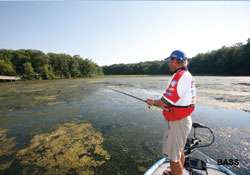
All bass fishermen have a favorite type of cover or structure they like to fish. It could be points, ledges, woody cover, rocks — the list goes on. Vegetation is often a favorite, and the different types, from milfoil in the South to tules out West, offer anglers myriad techniques and baits to harvest bass.
Here, four top BASS pros discuss their favorite types of cover, as well as techniques on how to dissect them.
KELLY JORDON:
HYDRILLA MATS
It's no surprise this Texan loves thick hydrilla, because then he can pull out his flipping stick and go mano a mano.
"Really big bass love that cover and I know they're going to be in the mat," he said. "A thick mat provides cover, shade, oxygen when the sun's out, food. That's why grass lakes have all the big bass. Guntersville is a prime example. It has some milfoil, but the majority of grass there is hydrilla. It's just hard to beat."
Jordon combines an Abu Garcia REVO STX reel with 65- to 80-pound-test Spiderwire Stealth on a 7-9 Fenwick heavy action rod. He teams that up with a 3/4- or 1-ounce tungsten Mega Weight and a 5/0 or 6/0 Owner wide gap hook.
"Sometimes I'll use a 2-ounce weight," Jordon said. "I'll put on a Lake Fork Tackle blue bruiser Craw Tube and off we go. It's close quarter, toe-to-toe battle — big line and big fish. Any flip can produce that bone-jarring strike, or you might simply lift up on the bait and it doesn't move. It's an awesome way to catch fish and it shines in summer."
GERALD SWINDLE:
RIPRAP
This Alabama pro grew up fishing a variety of lakes that included the notorious Smith Lake, called "the Dead Sea" by some locals, as well as Lake Guntersville and the Coosa River.
All of those have one thing in common: There is plenty of riprap and shoreline rock to work with jigs or plastics. Over time, Swindle took the experiences from those larger reservoirs, as well as the smaller creeks he fished as a youngster, and would rather see rock and riprap than anything else.
"I love the variety it offers because I may have from 1 to 15 feet to work a bait," he said. "I can work a bait up and down, looking for anything different or something protruding from the bank. Riprap has little nooks and crannies, too, for baitfish and crawfish."
A couple of years ago on Guntersville, Swindle pulled two big bass off a bridge piling that had a combination of old chunk rock and riprap. He did it with his favorite setup for riprap, a 3/8-ounce Arkie jig combined with a Zoom Super Chunk. Brown is a favorite color, as is black/blue.
"Riprap offers several things," he said. "If it's a long area then you have a lot of water that can be covered, and for that I might throw a Lucky Craft Flat MR crankbait. If it's smaller, or if you can pick out some of the subtleties, then you can concentrate on those. I'll also take a hard look at the corners of riprap if there is a bridge or opening, as well as any transitions, such as between the rocks and a clay or sandy bank."
ISH MONROE:
GRASS AND ROCKS
It was tough to pin down this California pro to just one type of cover.
"I like all kinds of grass and different kinds of wood, figuring out what's different about each one."
Pressed to pick, though, he said a mix of grass with rocks would be his choice. That includes banks with riprap or natural rock with some kind of vegetation nearby — the two can be a deadly combination.
"When I find that, I'm going to be throwing a Snag Proof frog because they eat it so well and it's weedless," he said. "I'll have one tied on at least 10 months out of the year."
Monroe uses the Snag Proof Tournament Frog on a Daiwa Light & Tough rod with 50- or 65-pound PowerPro braid spooled on a Daiwa Fuego reel. The combination is light enough to cast all day but strong enough to get bass out of the thick stuff.
"I'll pitch or cast the frog to the edge of the rock where it meets the grass, because normally there's a little trough or opening there," he said. "I'll let it sit a little longer before I move it and then walk the dog with it."
JUDY WONG:
HYDRILLA EDGES
Where you find grass, you'll find bass. So it's no surprise that this Women's Bassmaster Tour pro picks hydrilla as her top choice of cover.
"I like fishing all types of grass, but prefer hydrilla because it is more structured and has defined edges. It grows more vertically, and there are all kinds of shapes and cuts that offer a fish a place to hide."
Wong probes the hydrilla with a 5-inch Senko rigged on a 4/0 Daiichi Copperhead hook on 14-pound-test fluorocarbon line. She sometimes uses a spinning rod for wacky rigging, sometimes adding a rattle or piece of clothes hanger wire to help the bait fall differently.
"The wacky style has more action for slower presentations along the vertical edges," Wong said. "I'll also deadstick it. Pitch it into an opening and let it fall, then let it sit for a bit. It's irresistible to them."




